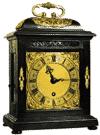- Tompion, Thomas
-
died Nov. 20, 1713, London) British clockmaker.Working closely with Robert Hooke and Edward Barlow, he made one of the first English watches with a balance spring and patented the cylinder escapement. The most famous clockmaker of his time, he is remembered as the father of British clockmaking.
 Bracket clock with oak case, ebony veneer, and gilt bronze mounts by Tompion, c. 1690; in ...By courtesy of the Victoria and Albert Museum, London
Bracket clock with oak case, ebony veneer, and gilt bronze mounts by Tompion, c. 1690; in ...By courtesy of the Victoria and Albert Museum, London* * *
▪ English clockmakerIntroductionbaptized July 25, 1639, Ickwell Green, Northill, Bedfordshire, Eng.died Nov. 20, 1713, LondonEnglish maker of clocks (clock), watches (watch), and scientific instruments who was a pioneer of improvements in timekeeping mechanisms that set new standards for the quality of their workmanship.LifeNothing is known of Tompion's formative years, and his father's blacksmithing is the only known link with a metalworking trade prior to his admission to the Clockmakers' Company in 1671, initially as a brother (apprentice) before gaining his freedom (journeyman status) in 1674. He was appointed clock maker for the new Royal Greenwich Observatory in 1676. Elected to the livery of the Clockmakers' Company in 1691, he served as junior warden in 1700 and rose to master in 1703.About 1707 Tompion was made a freeman of the city of Bath, where he is believed to have sought relief for an ailment, and he presented the city with a month-going timepiece that is still in use at the Pump Room.WorkTompion was among the first to apply Christiaan Huygens (Huygens, Christiaan)'s invention of the balance spring to watches. In particular, he is credited with inventing the Tompion regulation (1674–75), and he was the first (1695) to construct watches with a practical form of horizontal escapement. In clockwork Tompion used early forms of dead-beat escapement (1675–76), and he introduced pendulum spring-suspension for table clocks and Barlow's rack-striking mechanism (both about 1680). He was one of the first to use efficiently profiled machine-cut gearing and to protect movements from dust.Tompion's practical skills enabled him to supply any type of horological item, and his versatility is displayed by his earliest known commissions: a church bell of more than one hundredweight (8 stone, 112 pounds, or about 51 kg) in 1671, a turret clock for the Tower of London (London, Tower of), a quadrant of 3-foot (1-metre) radius for the Royal Society in 1674, and a balance-spring watch, under physicist Robert Hooke (Hooke, Robert)'s instruction, for King Charles II in 1675. Two year-going timepieces made for the use of Charles's first “astronomical observator,” John Flamsteed (Flamsteed, John), were installed in the newly built Royal Greenwich Observatory in 1676; they were paid for by Sir Jonas Moore, a mathematics instructor and surveyor.By this time, Tompion was established in business in Fleet Street, where he traded for the rest of his life at the sign of the Dial and Three Crowns. Remarkably, within just a few years of his arrival in London's horological community, he had become its most renowned member, and, with sound business acumen, he capitalized on the demand for his work and was soon the leading retailer. In 1690 he was employing as many as 20 people at his establishment. His customers were chiefly from the wealthiest classes—royalty and the aristocracy of England and other European countries. He also supplied items for presentation as diplomatic gifts. Some of his finest work, possibly in collaboration with the designer Daniel Marot (Marot, Daniel), was for King William III and Queen Mary II; examples include an outstanding year-going spring clock and a highly complicated traveling clock. Two year-going equation longcase clocks (grandfather clock) still in the royal collections were made for William III and Prince George of Denmark.About 1701 Tompion took into partnership Edward Banger, who had been trained in the business and had married his niece, but Banger was apparently dismissed from the premises about 1707, and for the next few years items were retailed with Tompion's name alone. About 1712 Tompion took into partnership George Graham (Graham, George), who had married another niece, and Graham succeeded to the business on Tompion's death. (Graham also shares the distinction of being buried in the same plot and covered by the same stone in Westminster Abbey.) During his life Tompion retailed about 700 clocks and 5,500 watches—including about 400 complicated repeating watches, as well as a small number of scientific instruments such as barometers (barometer), dials, and even a lunarium. He was one of the first to number his items in series.AssessmentAlthough Tompion abandoned production of both the dead-beat escapement in clocks and his horizontal escapement in watches, these undoubtedly influenced Graham's reintroduction of the dead-beat escapement (c. 1720) and his invention of the cylinder escapement (c. 1725). The standards established in Tompion's workshop were the foundations upon which the 18th-century makers—such as Graham, Thomas Mudge (Mudge, Thomas), John Harrison (Harrison, John), Thomas Earnshaw (Earnshaw, Thomas), and John Arnold—were to build in their successful searches for accuracy, especially with respect to determining longitude at sea.Jeremy L. Evans* * *
Universalium. 2010.
